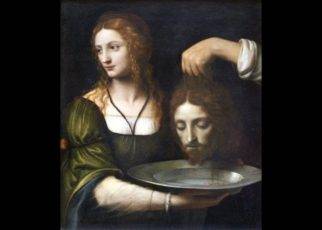Legends tell that when Leonardo da Vinci joined the studio of Verrocchio, one of the greatest artists of Florence, the young Leonardo was told that he would see fame and glory but not a lot of money.
As a scientist, inventor, anatomist, poet, musician and philosopher, da Vinci lived surrounded by the finest thinkers of his time, such as Marsilio Ficino, whose Neoplatonic thought influenced many paintings of the Renaissance like Botticelli’s Primavera and the Birth of Venus.
The hermetic Philosophy that underlay the studies of alchemy and cosmology can be seen through the elements of Leonardo da Vinci’s paintings, if one is able to see behind the images.
Philosophy of the Renaissance – Meaning and Symbolism of the Pyramid
In this painting, Saint Anne, the Virgin and the Child holding a lamb form a pyramidal structure. The top of the pyramid is Saint Anne’s head and she looks at her daughter, who is looking at the child. The three figures are connected through the eyes defining the right side of the triangle while the feet define the basis of the pyramid.
The pyramidal structure was very common during the Renaissance among Neoplatonic scholars as it symbolizes the holy trinity, or the three attributes of God. Father, Son and Holy Spirit was transformed into Mother, Daughter and Holy Spirit in this magnificent painting.
The child holding a lamb symbolizes the third attribute of God penetrating the manifested (physical) world, as the animal represents the matter. The boy is independent from his mother since she is unsuccessfully trying to retain him, symbolizing the mission of the Christ towards the material plain.
Neoplatonism and Hermeticism in Leonardo da Vinci’s Paintings
Leonardo da Vinci studied geology and the movement of water, which allowed him to be extremely meticulous in the disposition of the rocks in his paintings. The way the rocks are aligned under the feet of the characters indicate that they were depicted near an abyss, like in another painting called The Virgin of the Rocks. The abyss symbolizes death or the fall of the angels into the manifested world.
The meaning of St. Anne and the Virgin With the Child becomes clear for those who understand the philosophy that started to (re)emerge in the Renaissance.
The message of da Vinci in this painting is that there are three attributes of divinity that represent the ideal world. The physical world is an imperfect copy of these attributes and remains painful and mortal (represented by the abyss) as a result of the incapability of humans to mirror the ideal world. So the universe in its perfection sends an avatar (Jesus) to help the manifested world.
The child holding the lamb refers to a divine spirit merging with the animal world, the matter, in order to accomplish his mission.
The Church and the Hermetic Philosophy
Although the Church sponsored many paintings that had Hermeticism as a theme, some scholars argue that if Leonardo had lived fifty years later, he would have probably been executed by the Church for his philosophical ideas.
He died with little money as his predictors believed but his glory and fame remain alive until today, inspiring people to search for truth and beauty through the arts.





